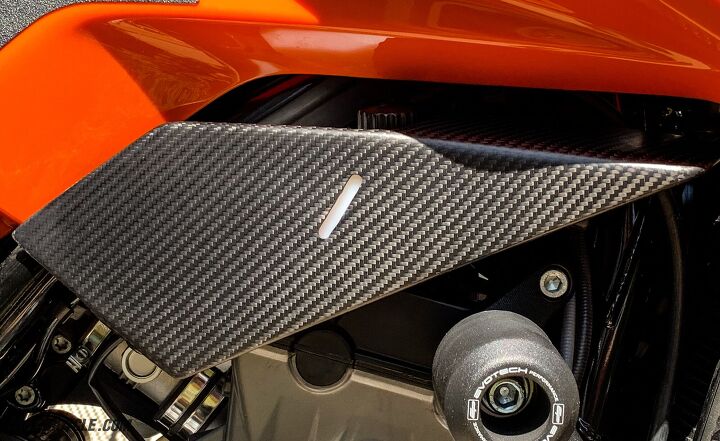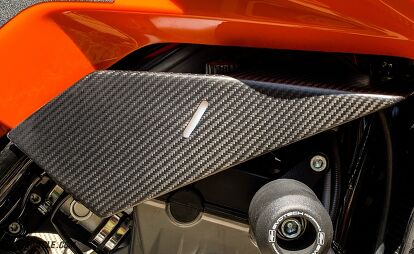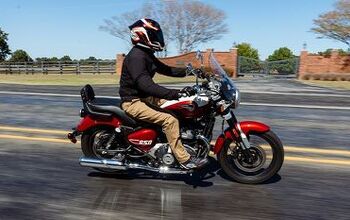Off Camber: The Call Of Carbon Fiber

Like chrome on cruisers
Carbon fiber, it’s light, it’s sexy, and it looks fast standing still. However, unless you’re a pro racer at the top of your game, no one could ever call it necessary. So, let’s just admit it, carbon fiber bodywork on sporting street bikes is the equivalent of chrome on a cruiser. While we can extoll its high-tech construction and light weight, we install it for pure vanity. Yeah, shaving an ounce of unsprung weight off of the front fender is always good, but can you or I feel the difference? Not likely. (An argument can be made for carbon fiber wheels, but other issues need to be considered for them on the street.)
Shop for the HF Carbon parts here
The vast majority of my previous aftermarket bodywork experience comes from fitting lightweight fiberglass racing skins. Installing them involved bending and clipping body panels in place followed by careful measuring, marking, and drilling the requisite holes. Other than that, it was swapping out OEM body panels that I’d inadvertently modified (thanks gravity), and they always fit perfectly – like they’d come from the factory.
Replacing the rear hugger and the back half of my front fender provided my gateway into carbon fiber. All those expensive European sporty-bikes had them. So, why shouldn’t my KTM? Thus began my research. In the end, I had almost a half-dozen vendor websites from all over the world saved in my bookmarks, but I settled on HF Carbon in Germany primarily because the company offers carbon fiber with a matte finish. As much as I like the look of carbon fiber, I think its glossy finish can be a bit showy.
When the fender and hugger arrived, the construction was solid (not the thin, flimsy carbon fiber I’ve grown to dislike on the heel guards that came with my PowerParts rearsets). These parts had a flawless finish, substance, and still weighed less than stock. The front fender tipped the scales with a 1.45 oz. saving, and it only cost me $150 per ounce to save that weight. The hugger yielded similar results: 1.02 ounces saved for $153. Yet, I was ecstatic. The look is exactly what I wanted. While the hugger bolted straight into place, the fender required some trimming of the OEM front section’s mounting points. Not a factory fit, but nothing a matte knife with a fresh blade couldn’t handle.
The final tally of my first HF Carbon purchase: front fender $219, hugger $153, and a combined weight savings of 2.45 oz. Not exactly a logical investment but a well-constructed one, nonetheless.
Jump ahead nine months to May 2020, and I, once again, found myself, credit card in hand, looking to remedy the ugly black side panels just below the fairing on my 790 Duke. (Clearly, I’d spent too much time in the garage staring at my bike during lockdown.) This time, instead of arriving in just over a week from its long trip from Germany, the parts took a whopping 40 days to arrive. Thanks to the coronavirus, my package languished at the Frankfurt airport for over 30 of those days, awaiting its turn in the diminished international flight shipping queue. HF Carbon’s representative handled my semi-weekly emails with patience and good humor.
As with the front fender, the parts needed a little massaging to fit. The Ignition Switch Cover didn’t fit over the ignition switch without a little grinding from my Dremel to remove some excess resin. The weight savings was 1.38 oz and a personal best cost/ounce-saved of $78! Yes, this is a completely unnecessary bauble, but it makes me smile when I put my key in the ignition.
The carbon fiber side covers were necessary because (HUGE RATIONALIZATION) they fixed a design flaw in the 790 Duke’s appearance. Really. The left cover bolted on almost as if it were an OEM part. However, since the cooling system overflow tank mounts to the inside of the right side cover, mounting it took a little more time. The tank needed the tang that slides into the cover to be cut shorter and filed down to fit in place. Next, the tank’s mounting hole had to be enlarged to allow the screw to mate with the mount on the side panel. Hardly a turnkey bolt-on, but still, it required just 15 minutes to remedy this issue. I’m sure that some people would balk at needing to perform those modifications to install a set of $230 side covers, but given that I started my motojournalist career at a cruiser magazine, I’ve been down the massaging with a grinder path before. I think it just comes with the customizing territory. Also, I saved 1.76 oz. between the two covers (for $130 per ounce).
So, what have we learned? The first carbon fiber part you install is like the schoolyard drug sample. Watch out or you may find yourself with an expensive habit – one that can easily get out of hand. (Cruisers call it chrome and leather disease.) Additionally, when installing custom bodywork, you may need to do some tweaking of some parts, but it isn’t a big deal if you’re patient and have a steady hand.
Still, you should see how that carbon fiber weave pops in the sun.
Shop for the HF Carbon parts here
We are committed to finding, researching, and recommending the best products. We earn commissions from purchases you make using the retail links in our product reviews and other articles. Learn more about how this works.

Like most of the best happenings in his life, Evans stumbled into his motojournalism career. While on his way to a planned life in academia, he applied for a job at a motorcycle magazine, thinking he’d get the opportunity to write some freelance articles. Instead, he was offered a full-time job in which he discovered he could actually get paid to ride other people’s motorcycles – and he’s never looked back. Over the 25 years he’s been in the motorcycle industry, Evans has written two books, 101 Sportbike Performance Projects and How to Modify Your Metric Cruiser, and has ridden just about every production motorcycle manufactured. Evans has a deep love of motorcycles and believes they are a force for good in the world.
More by Evans Brasfield






































Comments
Join the conversation
Not including a picture of the bike with the new cf bits is criminal
I've never understood why, when weight savings is the issue, no one ever seems to consider weight reduction of the rider which costs.............nothing and makes the rider look much better in most cases. When I was heavy, really heavy, I lost 50 lbs. in a summer. That was in 1967. Have kept the weight off since then with some work and you can imagine the savings in bike gas over the last 52 years. Cost?, actually saved money on food!